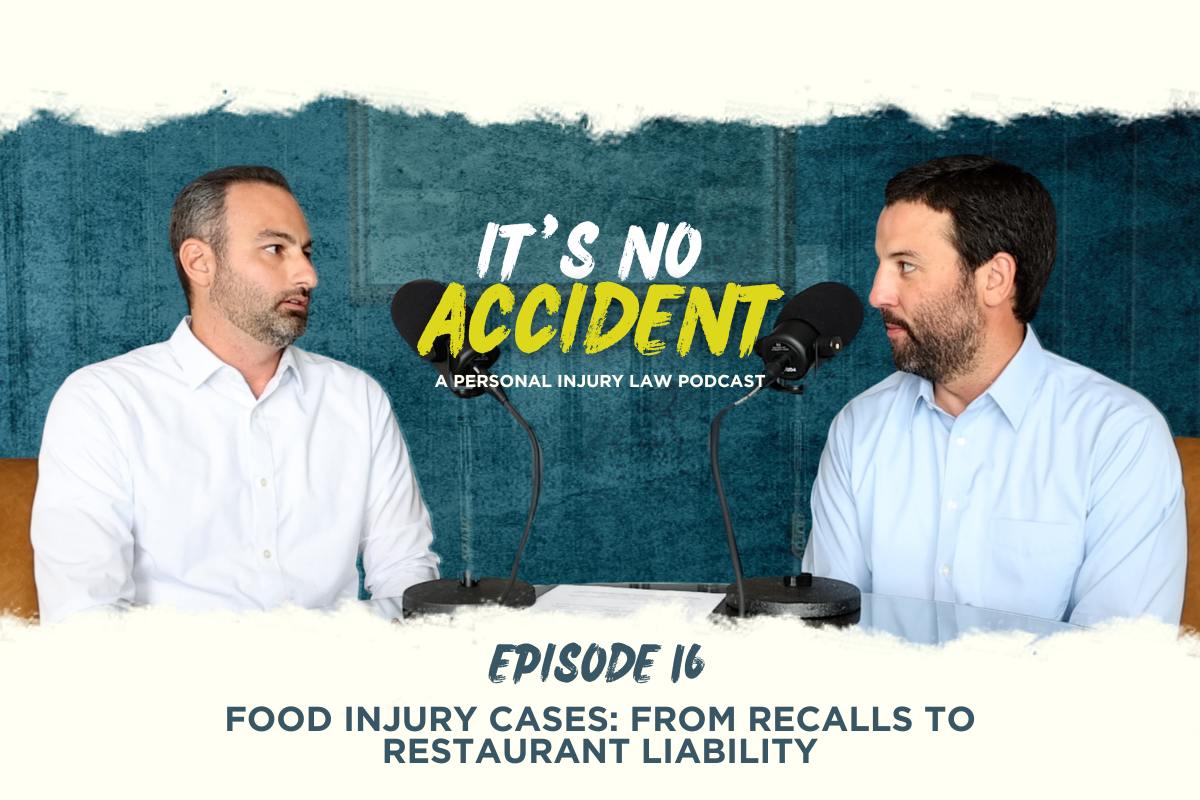
Podcast Description
In this episode of It’s No Accident, Jaeson and Mark dive into the real-world challenges of food-related injury cases—from major food recalls to everyday incidents of food poisoning. They break down why recall cases are usually more straightforward, while proving a one-off food poisoning claim can be tough without strong evidence like medical records or saved food samples.
They also share stories about injuries caused by unexpected objects in food—like screws or pits—that lead to dental damage and more. These cases can get messy fast, especially when it’s unclear where the contamination happened. Jaeson and Mark explain how they sort through the details to fight for their clients. Don’t miss this eye-opening episode—listen now!
Episode Transcript
All right, I know one thing that has been in the news a lot recently is food recalls. In my mind, it breaks down into two types of cases: one is a food recall case, where there’s a confirmed recall on a product, someone consumes it, gets sick, and there’s a clear claim. The other is more of a food poisoning case, where someone eats food from a restaurant or grocery store, gets sick, but there’s no recall—yet there’s still potentially a case.
I think you recently resolved one of those food poisoning cases, right? Talk about that a bit.
Yeah, it was a food poisoning case, which is more difficult than a food recall case. A food recall case is generally easier because the manufacturer is basically admitting liability. They’re saying, “Look, something went wrong. We ended up with E. coli or salmonella in our lettuce, tomatoes, or whatever it might be.” Those cases are simpler because it’s just a matter of assessing the damages.
Food poisoning cases, especially one-offs, are tougher. A lot of people get sick and just assume it was the flu or something else they ate, so they don’t take action. You could have 10 people get sick from the same lettuce at a restaurant, and only one might report it. That person comes to an attorney, and we’re in a tough spot. We can see there’s a potential case, but the restaurant or manufacturer is going to argue, “No one else complained. It must’ve been the flu or something unrelated.”
We’re up against that defense, where they say, “Your client didn’t eat anything for 12 hours before coming to our restaurant, but we didn’t get any other complaints, so it must’ve been something else.” It could be that the food wasn’t inherently bad, but maybe the cook undercooked the meat or eggs and didn’t kill the bacteria like Salmonella or E. coli.
From a broader view, the case with the recall is always preferable. But if someone has serious damages and can put together a timeline showing they only ate at that one place, you can bring a food poisoning claim. We’ve handled several of these.
The ideal situation, from a legal standpoint, includes a solid timeline: what they ate before, what they ate afterward. Sometimes, clients even save the food—if they took a bite, felt something was wrong, and froze it. That can be sent for testing, and if the bacteria or virus is found, that’s powerful evidence.
Also, going to the hospital is important. Getting diagnosed—ideally with specifics like E. coli or Salmonella—strengthens the case. We’ve both talked to people who were sure they had food poisoning, but they didn’t go to the doctor, and there’s no medical evidence. That makes it really hard to prove.
And look, it’s tough to get up and go to the hospital when you feel that sick. I’ve had food poisoning—it’s miserable, like the flu times ten. You’re nauseous, exhausted, and dealing with both ends. But going to the hospital and getting lab work done helps confirm what’s going on.
If you can pair that diagnosis with a clear timeline, then you can start putting together a strong case. When it’s a recall, like you said, the company is basically admitting there was a problem. You still want to go to the doctor, but also try to save the packaging or leftover food. Whether it’s spinach or carrots or something else, saving even a small amount can be helpful.
And if not the food itself, at least try to save receipts or pull up credit or debit card charges to show that you purchased the recalled item. That at least proves that you bought and consumed the product.
Another category we see in food cases is physical contaminants in food. We’ve had clients find screws in their food, bite down, and crack a tooth, leading to extensive dental work. Or something like a peach pit in a product that wasn’t supposed to have one—causing choking or dental injuries.
These cases seem straightforward, but they often raise questions from the defense: Where did the contaminant come from? Was it in the product when it left the manufacturer, or did it get there later during packaging or handling?
Everyone points fingers: the supplier, the packager, even the client. They might say, “Maybe you dropped the screw in the food yourself.” They’ll ask, “When did you open it? Did you eat it all in one sitting? How long was it in your cupboard? Who else had access to it?”
So you start with a client who says, “This should be open and shut. I cracked my tooth on something that shouldn’t have been in the food.” And we have to say, “Hold on, it’s not that simple.”


